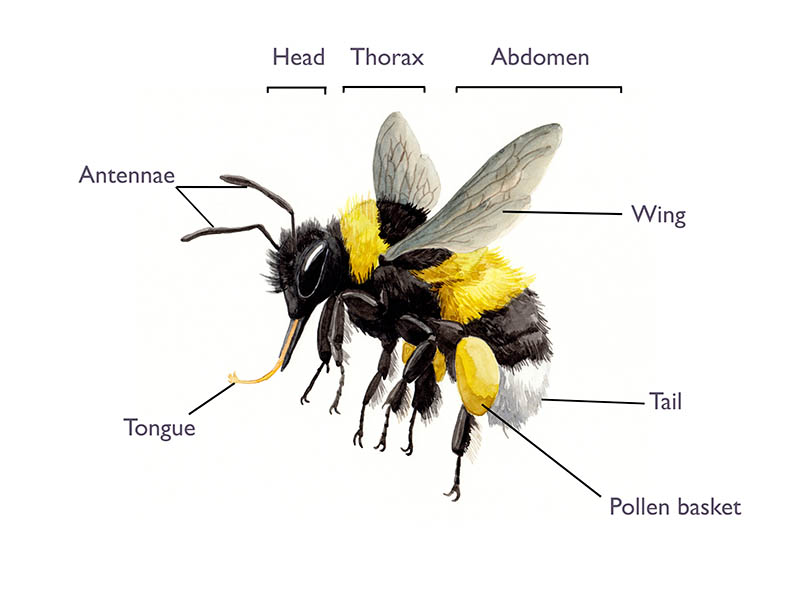Bumblebees
There are approximately 250 species of bumblebee in the world. Bumblebees evolved in the Himalayas around 35 million years ago, and all species are quite closely related.
There are 25 species of bumblebee in the United Kingdom. Only eight of these are regarded as common, and these species account for the majority of bumblebee sightings.
The first bumblebees to appear in spring are queens, followed by workers (non-reproductive females), then males and new queens. Fertilised queens hibernate over winter, ready to start a new colony in the spring.
Bumblebee anatomy
Bumblebees are insects. They have six legs, four wings, two antennae, large eyes and a tongue that varies in length depending on species. Their body is divided into 3 sections: head, thorax and abdomen.
Bumblebees are generally larger than other types of bee and are fluffy in appearance. Their hairy bodies make them well adapted to cold climates, and enable them to forage on cold days early in spring. The colour of the hair varies between species, and usually appears as stripes or bands.

Life cycle
Bumblebee queens emerge from hibernation from late February, having mated the previous summer. They search for a nest site, and once found, provision it with nectar and pollen. The queen lays just a few eggs at first and uses her body as an incubator. The eggs hatch into larvae and are fed nectar and pollen, before pupating and becoming worker bumblebees. These bees then forage for pollen and nectar, and raise further eggs laid by the queen who no longer leaves the nest. All workers are females, and the males (drones) are produced later in the season, along with new queens. The new queens will feed and mate before hibernating, ready to establish new colonies the following spring. The old queen, workers and males all die.
Cuckoos
Some bumblebees do not raise their own young and are actually parasites of other, similar looking bumblebee species. They are known as cuckoo bumblebees, and there are six species in the UK. Females displace the ‘true’ queen bumblebee and lay their own eggs in the nest, which the host workers then raise.
Cuckoo bumblebees tend to be large, with a strong build, box-shaped heads and dark, smoky looking wings. Compared to other bumblebees, their hair is sparse, so their hard, shiny bodies are visible beneath, and the end of their abdomen appears more pointed. Unlike other bumblebees, female cuckoo bees lack pollen baskets.
Observing bumblebees
- You are most likely to see one of the common species, so it’s worth becoming familiar with these before you begin your surveys. Watch our video for a quick introduction to the UK’s most widespread and common bumblebee species.
- Pay attention to the colour of the tail in particular as this will help you narrow down the possible species. UK Bumblebees have either white/buff, red/orange or ginger/brown tails.
- Only true bumblebee queens and workers have pollen baskets on their hind legs. Often a ball of pollen will be present, but when empty, a shiny surface fringed by hairs will be visible. If the bumblebee has hairy hind legs, it will be a male or cuckoo bumblebee.
- Be aware that bumblebees fade in colour and lose hair as they age, so if it’s late in the season once bright red tails will appear orange or buff for example.
- Your location and the time of year will affect which species and castes you will see – check our ID guide for information on distribution and flight season.
- Try not to cast a shadow on the bumblebees, as this often causes them to fly away!
- Find out more about the UK’s 25 bumblebee species by visiting our ID Guide.

